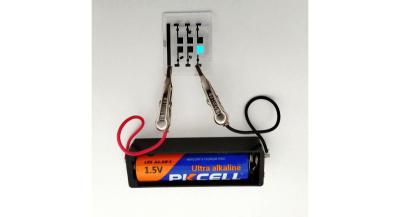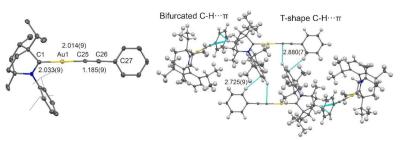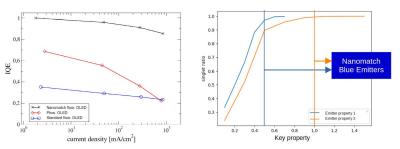The Elec: UDC's blue PHOLED material is still unstable, may delay market introduction
Universal Display Corporation has announced several times that it is progressing with its blue PHOLED material development, and it is on track to release the first commercial material by the end of 2024. In November 2023 we reported that UBI estimates that Samsung has delayed the adoption of a blue PHOLED to the second half of 2025.
 Now there's a new report in Korea that claims that UDC's blue PHOLED project is facing technical challenges, and UDC is still not able to achieve a long-lasting blue emitter at the right color point. It will be interesting to know whether UDC addresses this issue in its next investor conference call (May 2nd).
Now there's a new report in Korea that claims that UDC's blue PHOLED project is facing technical challenges, and UDC is still not able to achieve a long-lasting blue emitter at the right color point. It will be interesting to know whether UDC addresses this issue in its next investor conference call (May 2nd).
Researchers develop a blue fluorescent OLED device with ultra-low turn-on voltage
Researchers from the Tokyo Institute of Technology, Osaka University, University of Toyama and Shizuoka University have developed a fluorescent blue (462 nm) OLED device that features an ulta-low turn-on voltage of 1.47 V (at 100 nits). The researchers say this is very low, as similar commercial blue devices typically need around 4 V.
To achieve that low turn-on voltage, the researchers built a new device, as they realize that the choice of materials significantly influences the device's turn-on voltage. The device itself is an upconversion OLED.
Researchers develop promising near-UV CMAc OLED emitters
Researchers from the University of Manchester, led by Prof. Alexander Romanov, developed a promising new Carbene-Gold-Arylacetylide (CMAc) OLED near UV emitter type. The researchers also detail a strategy to develop longer device lifetimes for such emitters.
The new emitter exhibits an efficiency of 1% EQE, and a lifetime of 20 minutes at a practical brightness of 10 nits (LT50). This is low compared to commercial OLEDs - but it is actually quite outstanding for such an emitter, and the researchers say that this is among the longest lifetimes for a near UV-OLED at a practical brightness ever reported. In addition, organic fluorescent and TADF emitters rarely exceed 1% EQE at practical brightness.
Nanomatch announces a novel class of emitters for efficient and stable blue OLEDs
This is a sponsored post by Nanomatch
Using their in-house virtual design tools, Nanomatch developed a new class of emitters that enables the production of stable, fluorescent OLED devices with close to 100% internal quantum efficiency also in the blue color range.
The specific class of fluorescent emitters facilitates the generation of only singlets with radiative decay of the order of 10-8s, thereby eliminating quenching processes induced by long-lived triplets. Having filed the patent end of February 2023, Nanomatch is now looking for partners to commercialize this new concept in order to realize efficient, stable blue OLEDs on an industrial level.
Kyushu University researchers developed a promising new two-unit stacked tandem Hyperfluorescence blue OLED emitter system
Researchers from Kyushu University reported that they have developed a promising new blue OLED emitter system, based on a two-unit stacked tandem hyperfluorescence OLED with improved singlet-excited-state energy transfer from a sky-blue assistant hetero-donor-type TADF (HDT-1) dopant.
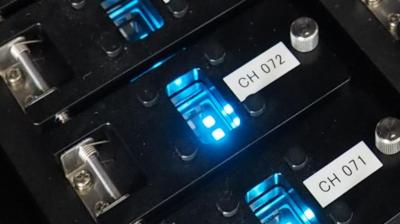
The research reports that the new emitter system offers a pure-blue color (CIE 0.13, 0.16), a narrow spectrum (full-width at half-maximum of 19 nm), an EQE of 32% at 1,000 cd/m2 and a lifetime of 18 hours LT95. The lifetime is still lacking, but with stricter control of device fabrication and procedures the researchers say they expect that device lifetimes will further improve to rival commercial fluorescent blue OLEDs.
Kyulux updates on its latest Hyperfluorescence TADF emitter performance
Kyulux presented a new paper at SID Displayweek, that shows the latest progress of the company's Hyperfluorescence OLED emitter platform. You can see the latest performance chart below.
Hyperfluorescence combines TADF and fluorescence emitters, which enables high-efficiency (~100% IQE) emitters that feature long lifetimes and a very narrow emission spectrum. The company's yellow HF emitter is already commercialized, and now Kyulux says that its red and green materials are "close to commercialization". The company is also improving the color point and lifetime of its HF blue emitters.
Amber Molecular raises $5 million to advance its fluorescent OLED R&D
Amber Molecular announced that it has completed its Series A funding round, raising $5 million USD, led by Phoenix Venture Partners.
Amber Molecular was established in 2017 by researchers at The University of Toronto in Canada to develop novel fluorescent OLED emitters. Amber Molecular's patented family of fluorescent OLED emissive materials produce photons in the orange, red and infrared spectrum, targeting new OLED applications.
A Q&A with Dr. York Tsai, Wisechip's Vice President of R&D
WiseChip Semiconductor, based in Taiwan, is one of the world's leading PMOLED maker (in fact in 2015 Wisechip said it's the world's second largest). Wisechip is developing next-generation PMOLED displays, including flexible panels, transparent panels and Hyperfluorescence/TADF PMOLEDs.
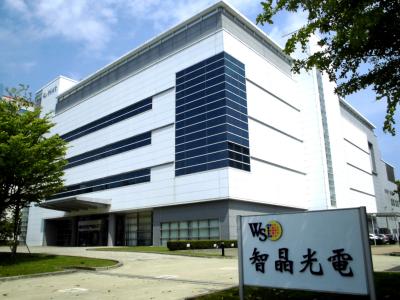
WiseChip recently announced its first, and the world’s first, Hyperfluorescence display, using TADF materials provided by Kyulux. Can you tell some more about this display and its properties?
This 2.70 128x64 product is adopted mostly in industrial products. The size matters in such market but the main problem was to increase the brightness due to the limited efficiency of the fluorescence emitters. The Hyperfluorescence technology helps to settle the problem and can reach up 2.5 times brighter. It performs much better readability so users do not have to stand right in front of the device. This feature adds to the value of the end product.
A Q&A with Cynora's CEO, to discuss the company's new blue emitter
OLED material developer Cynora recently announced its first commercial product, the cyBlueBooster fluorescent blue emitter that is 15% more efficient that current fluorescent blue emitters on the market.
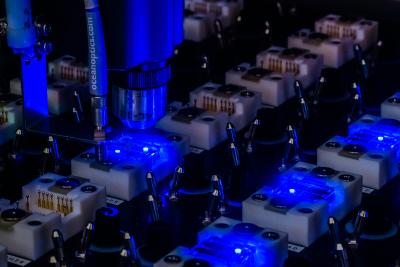
This was a very interesting announcement, and Cynora's CEO Adam Kablanian was kind enough to answer a few questions we had to help understand the new material and Cynora's current business and latest technology.
Cynora announces a new blue fluorescent emitter that is 15% more efficient than current emitters
OLED material developer Cynora announced its first commercial product, a fluorescent blue emitter that is based on an "advanced molecular design" that is 15% more efficient that current fluorescent blue emitters on the market. Cynora brands its new material as cyBlueBooster, and it says it is currently available for commercialization in several shades of blue.
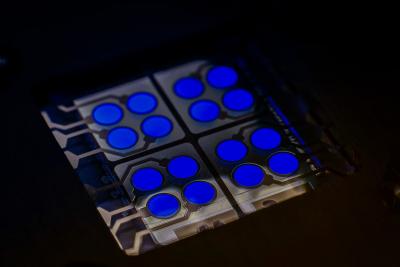
This could be very exciting news - while the whole industry is looking for next-generation emitters using TADF or PHOLED technologies, Cynora could have found an easier path to reduce power consumption by 15%. OF course a TADF or PHOLED emitter will achieve a reduction of 75% in power consumption compared to currently-used fluorescent emitters.
Pagination
- Page 1
- Next page
